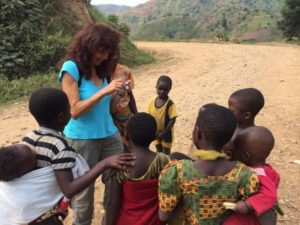JWW Board Member Vaughan Meyer is traveling with four other JWW delegates in Congo’s eastern provinces. They will work with survivors of the country’s decades-long conflict, which has claimed nearly six millions lives. And, they will meet with JWW’s partners on the ground, with whom JWW works to create innovative programs and projects that change lives and transform communities.
It was a tough travel day, with over six hours in a car on very rough dirt roads—but it was worth it. We saw the lush and beautiful countryside that I have heard and read about, and watched day-to-day village life unfold: young mothers and small children caring for babies and performing heavy domestic chores amidst the background of local commerce, lack of infrastructure, government road tax barriers (you must pay to pass) and housing of all types. I am involved in the advocacy side of the work that we do at Jewish World Watch, and now being here in person has made me feel better informed, emboldened and empowered to continue. In village after village, we saw hundreds of children of all ages by the side of the road, and were told that virtually none of these children have access to education. In fact, in a country of 71 million people, 7 million are children eligible for school, but who cannot afford to attend. Jewish World Watch is already involved with some very successful educational projects in the DRC, but these numbers floored me. Diana and I, along with our guide Amani, traveled today to the village of Nyambibwe and the Kalimbi Tin Mine. Kalimbi is one of the first mines in South Kivu to receive the “conflict free” green certification. Green indicates that no armed groups are present, and no children are working in the mine. The children had stopped working in the mine at Kalimbi, thus ensuring the “green” certification, but they now lacked access to educational opportunities. Education is not free in Congo and these were very poor families who could not afford to pay the school fees. One of the highlights of the day was the town meeting. When we arrived at the relatively large village of Nyabibwe, we were immediately surrounded by many village leaders and introductions began. After meeting with the Chef du Poste, the head of the village, we proceeded to what we were told was going to be a conversation with “some of the children” who used to work in the mine.
As we proceeded to what we thought was a meeting with a few of the children, we approached what looked like a one-room schoolhouse, and were whisked in the door. As our eyes adjusted to the dim light, we realized the room was packed with hundreds of children and their parents, filling the benches here and in the adjacent annex. They all stood, clearly to acknowledge us. I was completely overwhelmed. We were surveyed by hundreds of curious eyes as we made our way to the chairs set up in front for us. We had arrived later than expected due to some unavoidable Congolese bureaucracy, and we quickly understood that all these people had been sitting here in the stifling hot for over 45 minutes awaiting our arrival. Again, I was overcome with emotion. I was humbled and honored that this meeting was so important to them. Clearly, very few visitors make the difficult journey to Nyambibwe, and then sit and meet with the villagers to listen and learn about their situation.
After some welcoming comments and introductions, Diana and I each said a few words about Jewish World Watch, from the work we do in Congo with local partners to advocating back in the United States. Then, one of the older children came forward to read us a beautifully written letter which welcomed us with love and thanks on behalf of all the children. He explained what the children had been exposed to since they left the mines: lack of education, economic exploitation, sexual abuse, and so much idle time that many had become nothing but street children. He expressed the hope that we could help remedy the situation, or at least tell others in the international community who might be able to help, because, he said, the future of the country depends on the children and how they are cared for. And as I looked out at the sea of Congolese children sitting right in front of me, advocating for their own future, I was filled with inspiration and tremendous hope for this community. There is nothing these children and their parents want more than the opportunity for education and a better future. As we are were there in person, it is now our job to be their voice to the rest of the world. After more letters from parents, the head of education, and community leaders, Diana and I were ushered outside, shaking hands and exchanging greetings and thank-you’s in Swahili all the while. We were lead to the entrance to the Kalimbi Tin Mine. Diana will be blogging about our actual visit inside the mine. It was amazing walking through the mine (160 meters in), and I think we shocked everyone there that we actually did it! I was especially grateful to have a chance to speak to six of the artisan miners working inside. We ended our extraordinary visit taking pictures and playing with about 15 young children who surrounded us as we waited near the mine for our ride. We laughed with and marveled at the bright and joyous kids who are the future of Congo.


